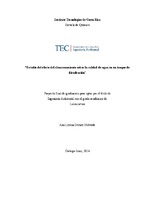Mostrar el registro sencillo del ítem
Estudio del efecto del almacenamiento sobre la calidad de agua en un tanque de distribución
| dc.contributor.author | Gómez-Valverde, Ana Lorena | |
| dc.date.accessioned | 2014-08-27T21:05:05Z | |
| dc.date.available | 2014-08-27T21:05:05Z | |
| dc.date.issued | 2014 | |
| dc.identifier.uri | https://hdl.handle.net/2238/3285 | |
| dc.description | Proyecto de Graduación (Licenciatura en Ingeniería Ambiental) Instituto Tecnológico de Costa Rica, Escuela de Química, 2014. | |
| dc.description.abstract | Distribution of tanks have been linked in various studies with the effect of storage in water quality related problems concerning the disinfection process by deficiencies in the chlorine time of contact and hydrodynamics, specifically, because poor mixing, short circuit, dead zones mixing and thermal stratification; however, Costa Rica are few or no studies to confirm or refute such scenarios occur in distribution tanks. Therefore it is necessary to begin by assessing the hydrodynamic conditions, the spatiotemporal variation of free chlorine and temperature with appropriate and applicable to different administrative entities of the water supply systems protocols. To contribute this need the present research was conducted in the New Tank in San Ignacio de Acosta, where the hydrodynamic conditions and the spatiotemporal variation of the concentration of chlorine and temperature tank were evaluated. It was necessary to perform the test with instantaneous tracer injection of sodium chloride, the resulting data using four hydrodynamic models were analyzed: analysis of Wolf-Resnick, Trend Curve, Peclet number and Tanks in Series to evaluate the hydrodynamic conditions. With regard to space variation-temporal residual chlorine and the temperature, the study included nine sampling points into the tank through the use of water traps and a suction pump. Also we included two points abroad, one at the inlet and one at the outlet pipe. The set of data obtained for the study of variation space - time were analyzed with analysis of variance and Tukey's test. Moreover, analyzed the operation and maintenance of the tank related the test results with their physical explanation and so generate recommendations that we will improve water quality was performed. It was found that the new tank had percentages of 33% of mixed flow, plug flow 11% and 56% of dead zones in accordance with the method of Wolf- Resnick. It was also confirmed with the four methods aforementioned, the flow reactor was the ideal complete mixing reactor operation more approached the tank , but misses in all this behavior to be three methods the presence of a short circuit. That proceeds of short circuit and deficiency in the mixture was found actual holding time was 498.0 min, 15 min to less theoretical. Added to this the variation of the levels in the tank didn´t exceed 30 %, recording minimum values of 2 m, which together with possibly short circuit causes 56% of dead zones. The input and output configuration allows the presence of short circuit and therefore was recommended relocate one pipeline; regulating flow of income was recommended in conjunction with control levels to prevent foster varying volumes and prevent aging water. Finally, the feasibility of hydrodynamic studies related to water quality in storage tanks by a process applicable to the local context was found. The problem of maintaining high percentages of stored water, It wasn´t taking into account as the configuration of the inlet and outlet of the tank can affect water quality, demonstrating in turn that the storage tank wasn´t the structure is evidenced ideal for efficiently performing the disinfection process, constricted a valuable contribution in terms to risk minimization in water quality in the supply system in San Ignacio de Acosta. | es_CR |
| dc.language.iso | es | es_CR |
| dc.publisher | Instituto Tecnológico de Costa Rica | es_CR |
| dc.rights | acceso abierto | es |
| dc.subject | Agua potable | es_CR |
| dc.subject | Desinfección | es_CR |
| dc.subject | Calidad | es_CR |
| dc.subject | Cloro | es_CR |
| dc.subject | Hidrodinámica | es_CR |
| dc.title | Estudio del efecto del almacenamiento sobre la calidad de agua en un tanque de distribución | es_CR |
| dc.type | proyecto fin de carrera | es_CR |


